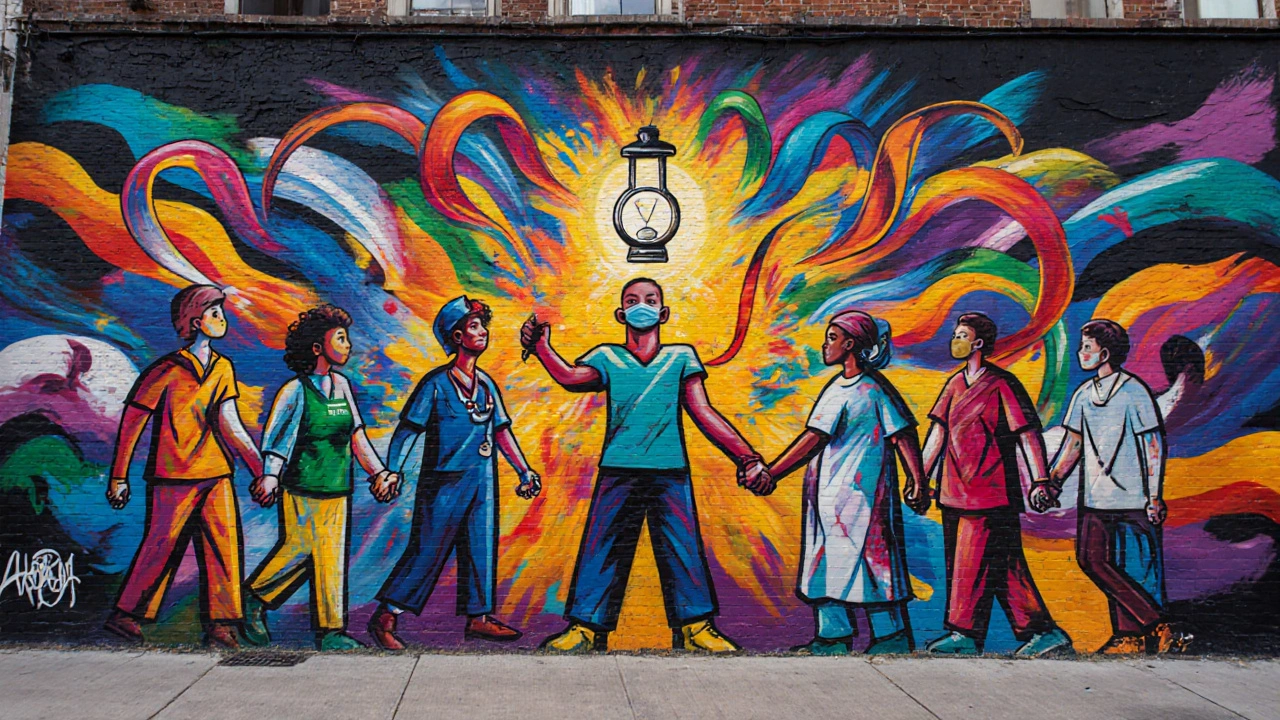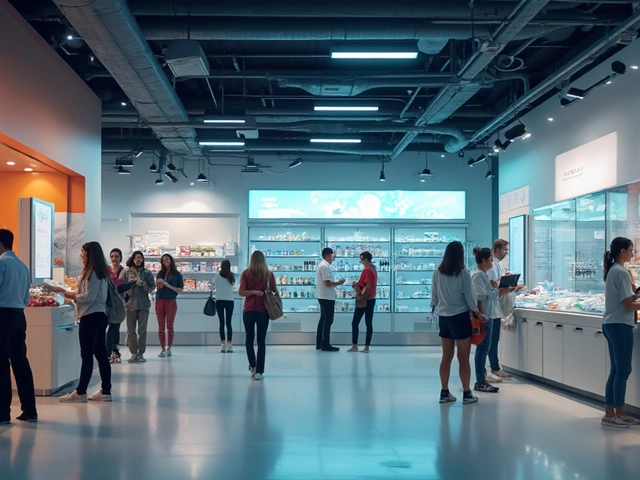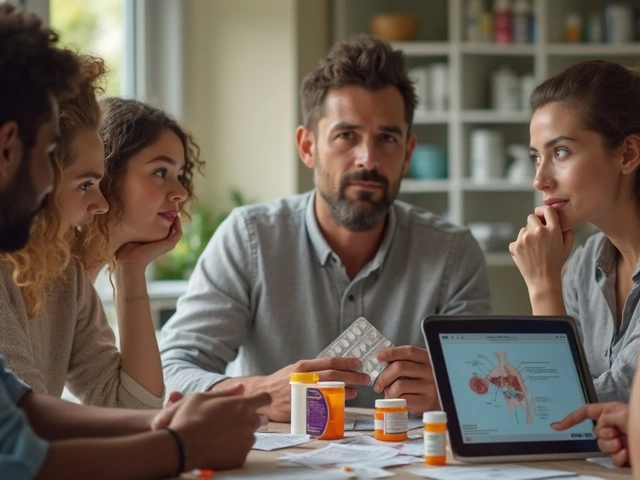Leprosy Awareness Quiz
b) Bacteria (Mycobacterium leprae)
c) Fungus
d) Parasite
b) Loss of sensation
c) Fever
d) Muscle weakness
b) 6 months
c) 24 months
d) 3 months
b) It reduces disability and improves outcomes
c) It makes the disease incurable
d) It increases stigma
b) Stigma
c) Poor healthcare infrastructure
d) Ineffective treatments
Key Takeaways
- Leprosy Awareness Day spotlights the need for early detection and treatment.
- Stigma remains the biggest barrier to eliminating disease transmission.
- Multi‑drug therapy (MDT) can cure leprosy in most cases when started early.
- International bodies like WHO and NGOs drive policy, funding, and community outreach.
- Effective advocacy combines education, survivor stories, and clear government commitments.
When Leprosy Awareness Day is marked each year on January 30 to highlight the ongoing fight against leprosy and its social stigma, the world gets a chance to refocus on a disease that still affects over 200,000 people annually. The day isn’t just a calendar entry; it’s a rallying point for clinicians, policymakers, activists, and anyone who’s ever seen a scarred face and wondered why the fear still lingers. Below, we unpack why the observance matters, how advocacy works on the ground, and what you can do to help.
Leprosy Awareness Day serves as a reminder that, despite medical advances, the disease’s legacy of exclusion continues to shape lives.
Understanding Leprosy: The Disease and Its Cause
Leprosy is a chronic infectious disease caused by the bacterium Mycobacterium leprae. The pathogen primarily targets the skin, peripheral nerves, mucosa of the upper respiratory tract, and eyes. Symptoms range from mild skin lesions to severe nerve damage that can cause loss of sensation, muscle weakness, and, if untreated, permanent deformities.
Mycobacterium leprae is an extremely slow-growing bacillus that prefers cooler body regions, which explains why lesions often appear on elbows, knees, and ears. The bacterium cannot be cultured in a laboratory, making research challenging. Transmission is believed to occur through prolonged close contact with an untreated patient’s nasal droplets, though the exact mechanisms are still under study.
Why Stigma Still Persists
Historically, leprosy was called the "law of Moses" and associated with moral judgement. Those affected were forced into isolated colonies, a practice that lingered well into the 20th century. Stigma is the social disgrace and discrimination faced by people with leprosy, often leading to loss of employment, marriage prospects, and community support. Even in countries where the disease is rare, the fear of visible disfigurement fuels prejudice.
Recent surveys across India, Brazil, and Indonesia reveal that more than 40% of the general public still associate leprosy with ‘untouchability’. This misconception hampers early reporting because many hide symptoms for fear of rejection.
Early Detection Saves Lives and Reduces Disability
When early detection is achieved within the first six months of symptom onset, the risk of permanent nerve damage drops dramatically, and the disease becomes easily curable. Community health workers play a crucial role by conducting skin checks during routine visits and educating households about early signs: hypopigmented patches, numbness, and thickened nerves.
Countries that have integrated leprosy screening into primary health care-like Nepal and Ethiopia-have seen a 30% reduction in new cases over the past five years. The key takeaway? Early detection is a public health win‑win: it saves patients from lifelong disability and cuts transmission chains.
Effective Treatment: Multi‑Drug Therapy (MDT)
Multi‑drug therapy is the WHO‑recommended regimen combining dapsone, rifampicin, and clofazimine to kill Mycobacterium leprae. Introduced in 1981, MDT transformed leprosy from a hopeless condition into a curable disease for the vast majority of patients.
Standard MDT courses last 6-12 months for paucibacillary (few bacteria) cases and 12-24 months for multibacillary (many bacteria) cases. Side effects are generally mild, and adherence is boosted by community‑based distribution of medication packs.
According to the WHO Global Leprosy Report 2023, more than 97% of patients who completed MDT achieved full clinical cure, underscoring the therapy’s effectiveness.

Global Players Driving Change
The fight against leprosy is coordinated by a network of international agencies, national programmes, and NGOs.
World Health Organization (WHO) is the United Nations agency that sets global leprosy targets, supplies free MDT, and publishes annual surveillance reports. Its 2025‑2030 strategy aims to reduce the worldwide burden by 90% and eliminate disability grading of new cases.
In India, the National Leprosy Eradication Programme (NLEP) is a government‑led effort that balances case detection, treatment delivery, and anti‑stigma campaigns across 36 states. Since its inception in 1983, NLEP has contributed to a 75% decline in reported cases.
Non‑governmental organizations like The Leprosy Mission are an international Christian charity that provides medical care, rehabilitation, and livelihood support to people affected by leprosy in over 30 countries. Their survivor‑led advocacy workshops have been replicated in Tanzania, Brazil, and the Philippines, proving that peer voices resonate strongly.
Advocacy Strategies That Work
Effective advocacy blends data‑driven messaging with human stories. Here’s a quick checklist of tactics that have proven successful:
- Survivor Storytelling: First‑hand accounts humanise the disease and debunk myths.
- Policy Briefings: Presenting concise evidence to health ministries secures budget allocations for MDT and disability services.
- Social Media Campaigns: Hashtags like #EndLeprosyStigma generate millions of impressions during the awareness day.
- School Programs: Age‑appropriate curricula teach children that leprosy is curable and not a moral failing.
- Community Screening Drives: Mobile clinics paired with local leaders improve case finding in remote areas.
Combining these approaches creates a virtuous cycle: increased knowledge leads to earlier diagnosis, which in turn reduces visible disabilities and further erodes stigma.
Key Statistics at a Glance
| Metric | Value | Trend |
|---|---|---|
| Total new cases reported | 202,256 | ↓ 8% (vs 2022) |
| Countries with >1,000 cases | 5 | ↔ stable |
| Proportion of cases with Grade 2 disability | 6.2% | ↓ 2% (vs 2022) |
| Patients completing MDT | 97% | ↑ 1% (vs 2022) |
| Funding gap for NLEP (2024) | $85million | ↑ 12% (vs 2023) |
The numbers tell a hopeful story-treatment success is high and disability rates are falling-but the persistent funding gap and pockets of high prevalence remind us there’s still work to do.
How You Can Contribute on Leprosy Awareness Day
- Donate: Even a modest £20 helps fund a month’s supply of MDT for a patient in a remote clinic.
- Volunteer: Local NGOs often need language‑speaking volunteers to assist with education sessions.
- Share Information: Post one fact‑check about leprosy on your socials; the ripple effect can challenge misinformation.
- Advocate Locally: Write to your MP highlighting the need for continued research funding.
- Support Survivors: Encourage inclusive hiring practices for people who have completed treatment.
Every action, big or small, adds momentum to a global push that began decades ago.
Looking Ahead: The 2025‑2030 WHO Leprosy Strategy
In early 2025, WHO unveiled a five‑year plan focusing on three pillars: (1) accelerated case detection, (2) elimination of disability through post‑treatment care, and (3) intensified anti‑stigma campaigns using digital media. The goal is to bring the number of new cases down to under 100,000 annually by 2030.
Success will hinge on cross‑sector collaboration-health ministries, NGOs, academia, and the private sector must share data, resources, and innovative solutions like tele‑dermatology for remote diagnosis.
Conclusion: Turning Awareness into Action
Leprosy Awareness Day reminds us that medical breakthroughs alone won’t erase a disease that has been feared for millennia. The real battle is against the stigma that hides symptoms, blocks treatment, and isolates survivors. By combining early detection, effective MDT, and relentless advocacy, we can move closer to a world where leprosy is a medical footnote, not a social scar.

Frequently Asked Questions
Is leprosy still contagious?
Yes, but only when a person with leprosy has not yet started multi‑drug therapy. Once treatment begins, the bacterial load drops quickly, making transmission highly unlikely.
How long does MDT treatment last?
For paucibacillary cases, the regimen typically runs for six months. Multibacillary cases require 12 months of medication, though some national programmes extend it to 24 months for added safety.
Can leprosy cause permanent disability?
If caught early, most patients avoid lasting nerve damage. Delayed diagnosis, however, can lead to loss of sensation, muscle weakness, and facial deformities that may be irreversible.
What role do survivors play in advocacy?
Survivor voices are powerful because they personalize the disease, break down myths, and inspire community trust. Many NGOs base their outreach programs on survivor‑led workshops.
How can I support leprosy research?
Donations to accredited research institutions, participation in clinical trials (if eligible), and advocating for increased government funding are all effective ways to boost scientific progress.






Comments
Crystal Newgen
30/Sep/2025Leprosy awareness is definitely worth sharing.
Hannah Dawson
30/Sep/2025The quiz looks neat, but it feels a bit shallow. It lists the facts without digging into why stigma persists. A real analysis would question the funding sources behind the "awareness" campaigns. Also, the multiple‑choice format can oversimplify a complex disease.
Julie Gray
30/Sep/2025It is imperative to recognize that the narrative surrounding leprosy is meticulously curated by a coalition of powerful interests. The so‑called "global awareness" initiatives serve not only to educate but also to divert attention from the disproportionate allocation of resources to more profitable health concerns. Funding gaps, as noted in the report, are suspiciously filled by entities with opaque financial trails. One might conjecture that pharmaceutical conglomerates benefit from the continued perception of leprosy as an untreatable scourge, thereby sustaining demand for proprietary drug regimens. Moreover, the emphasis on survivor stories, while emotionally compelling, can be co‑opted to mask the underlying structural inequities that perpetuate disease transmission. The strategic placement of stigma‑focused messaging dovetails neatly with political agendas that favor surveillance over genuine community empowerment. Historical patterns reveal that governments have repeatedly weaponized disease narratives to justify invasive public health measures. In the present context, the push for digital media campaigns appears to be a conduit for data harvesting under the guise of advocacy. This data, once collected, can be leveraged to influence policy decisions that prioritize cost‑efficiency over patient dignity. The 2025‑2030 WHO strategy, although laudable on paper, may contain clauses that enable selective reporting of case numbers, thereby crafting a veneer of progress while concealing persistent hotspots. Furthermore, the reliance on multi‑drug therapy as a panacea neglects the nuanced realities of drug resistance emerging in certain regions. The article’s omission of any discussion on antimicrobial stewardship is a glaring oversight. It is also noteworthy that the projected reduction to under 100,000 cases by 2030 aligns conveniently with the fiscal timelines of major donors, suggesting a symbiotic relationship rather than an altruistic goal. While the rhetoric champions inclusivity, the operational frameworks often exclude the very voices they claim to amplify. The recruitment of survivors for advocacy work, although empowering, can inadvertently re‑legitimize an exploitative model if adequate compensation and support are not provided. Lastly, the persistent funding shortfall highlighted in the statistics underscores a systemic reluctance to fully invest in eradication efforts, hinting at an entrenched complacency within the global health establishment.
Lisa Emilie Ness
30/Sep/2025Great overview, very clear and concise. The focus on stigma hits home.
Emily Wagner
30/Sep/2025When we unpack the epistemic scaffolding of leprosy discourse, we encounter a lexicon saturated with biomedical determinism. Yet, the phenomenological experience of patients resists reduction to mere bacterial load. By invoking "social determinants" we open a portal to interdisciplinary praxis, marrying anthropology with micro‑biology. The term "multidrug therapy" becomes a metaphor for collaborative governance, not just a pharmacological regimen. Ultimately, the narrative must transcend the binary of cure versus curse to embrace a holistic schema.
Mark French
30/Sep/2025Julie, you raise some valid points about funding. Its concerning how some of these deals happen behind the scenes. We need more transparency so that the real victims get the help they deserve.
Daylon Knight
30/Sep/2025Emily's jargon is impressive but honestly sounds like a lecture you’d hear in a museum. Not everyone wants a dissertation while scrolling through Reddit.
Jason Layne
30/Sep/2025Julie’s conspiratorial lens is a reminder that hidden agendas often lurk beneath benevolent facades. The data manipulation you mentioned is not only plausible but historically documented. Governments have weaponized disease narratives to consolidate power while NGOs capitalize on donor fatigue. Ignoring these patterns does a disservice to the very communities we claim to protect.
Hannah Seo
30/Sep/2025For anyone looking to get involved, start by checking local health department resources; many offer free educational webinars. Volunteer with organizations that run community screening drives-these usually need people to help with logistics and outreach. Donating a modest amount can fund a month’s supply of MDT for a patient in a remote area. Finally, share accurate information on your social media to combat myths; even a single fact‑check can ripple out and change perceptions.
Victoria Unikel
30/Sep/2025Awareness is key.
Lorena Garcia
30/Sep/2025I love the practical steps, but I’m curious how we can adapt these ideas for small towns where medical services are scarce. Do you think mobile apps could help with early detection, or would that just widen the digital divide?
Dietra Jones
30/Sep/2025Just a tiny tweak: “scarce” should be spelled “scarce” – but you nailed the point! Keeping the language clear helps more people engage.
Marcia Hayes
30/Sep/2025Let’s keep the momentum going! Every share, every conversation, and every donation adds up. Together we can make leprosy a footnote in history rather than a daily reality for those affected.
Danielle de Oliveira Rosa
30/Sep/2025Contemplating the ontological dimensions of disease, one observes that leprosy transcends mere pathology; it becomes a cultural signifier of otherness. The metaphysical weight it carries is evident in how societies have historically inscribed moral judgments upon its sufferers. Yet, the biomedical narrative offers a pathway to demystify the organism, reducing mystique to microbial fact. In doing so, we confront the ethical imperative to dismantle the stigma that has ossified over centuries. The intersection of science and compassion therefore demands a praxis that integrates early detection with psychosocial rehabilitation. When the clinical lens aligns with community empowerment, the condition’s narrative shifts from inevitability to resilience. Moreover, the role of survivor testimonies cannot be overstated; they serve as epistemic bridges between abstract data and lived experience. By amplifying these voices, public health initiatives acquire ethical legitimacy. The allocation of resources, however, remains a contested arena; funding disparities reveal underlying power structures that privilege certain diseases over others. Addressing this inequity requires a re‑examination of global health governance. The 2025‑2030 WHO strategy, while ambitious, must be scrutinized for its implementation mechanisms to ensure accountability. In parallel, grassroots movements should be equipped with the tools to monitor progress locally. The convergence of top‑down policy and bottom‑up activism creates a fertile ground for sustainable change. Ultimately, the eradication of leprosy is not solely a medical triumph but a societal transformation that redefines inclusion and dignity.
Tarun Rajput
30/Sep/2025Delving deeper into Danielle’s profound discourse, one cannot ignore the symphonic interplay of linguistic cadence and sociopolitical critique. The eloquence with which she juxtaposes ontological musings against empirical data serves as a reminder that science does not exist in a vacuum but rather blossoms within cultural ecosystems. Her call for a dialectic between policy frameworks and community agency resonates powerfully, especially when considered against the backdrop of historical marginalization. By invoking the fossilized narratives of stigma, she urges us to excavate the buried prejudices that continue to shape public perception. The emphasis on survivor testimonies as epistemic anchors underscores a democratic turn in knowledge production, wherein lived experience validates and enriches statistical abstraction. Moreover, her interrogation of funding hierarchies illuminates the shadowy corridors where financial streams are diverted, often sidelining the very populations they purport to serve. This critique aligns with emerging scholarship that advocates for a re‑orientation of global health priorities towards equity and justice. In sum, her treatise is not merely an academic exercise but a clarion call to action, beckoning scholars, practitioners, and citizens alike to re‑weave the fabric of leprosy advocacy with threads of compassion, rigor, and inclusivity.
Joe Evans
30/Sep/2025Love the optimism, Marcia! 🌟 Let’s keep spreading the word and sharing those good vibes. 🙌
Colin Boyd
30/Sep/2025Honestly, all this hype around leprosy feels manufactured; the elite funders love a good cause narrative to polish their image while the real burden stays hidden.
John Petter
30/Sep/2025While your perspective is noted, it simplifies a multifaceted issue into a single conspiracy.